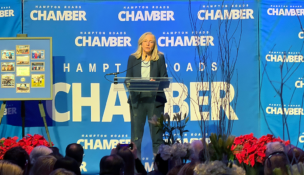Oyster farming gains traction in Virginia
Over the years, the Chesapeake Bay’s native oyster population largely has disappeared because of over-harvesting and disease. In the past decade, however, a new oyster aquaculture movement has taken off in the commonwealth.
“As oysters disappeared, people started to look at ways to artificially reproduce them,” explains Tommy Leggett, who owns Chessie Seafood and Aquafarms in the Wicomico community of Gloucester County, which provides 2,000 to 3,000 oysters a week to restaurants in Hampton Roads and other areas. Leggett also is an oyster restoration and fisheries scientist for the Chesapeake Bay Foundation.
A number of companies in Eastern Virginia are farm-raising oysters, a process they say yields not only a high-end product but also helps the Chesapeake Bay. The companies grow oysters from seed to market-size in trays in the bay, helping to filter its water.
“Oysters are the building block of the bay, so you’ll have more rock fish, crabs, shrimp. Everything feeds off the healthy oyster population,” says Travis Croxton, co-owner of Rappahannock River Oysters LLC in Topping, located in Middlesex County.
Ballard Fish & Oyster Co. in Cheriton on the Eastern Shore is one of the big players that take part in aquaculture, producing 6 million farm-raised oysters annually (though most of its business comes from wild oysters). Farm-raised oysters are typically sold at high-end restaurants, such as raw oyster bars. “They go for more money because they are beautiful as opposed to a wild oyster, which isn’t as pretty,” says Chad Ballard, owner of Ballard Fish & Oyster. Wild oysters are a larger market in Virginia, but go for a cheaper price point.
It was about 10 years ago that Croxton and his cousin, Ryan, inherited Rappahannock River Oysters from their grandfather. There was only one problem — they didn’t know how to grow oysters. With a little help from the Internet and another company that was starting out at the time, Chesapeake Bay Oyster Co., they soon learned the trade. These days they not only raise oysters but own three oyster restaurants, including the new upscale Rappahannock Restaurant in Richmond. They also own Rappahannock Oyster Bar in Washington and Merroir, a tasting room in Topping.
“It lets us showcase our product and talk to consumers about oysters and the bay and why that’s a good thing,” says Travis Croxton.
As the Croxtons’ business has grown, they’ve watched more oyster farmers crop up. “When we began a decade ago, there were, maybe, a couple of other companies starting to fool around with aquaculture,” says Travis Croxton. “Now, it’s probably hundreds of companies in Virginia alone, so that growth has been tremendous.”
o
















